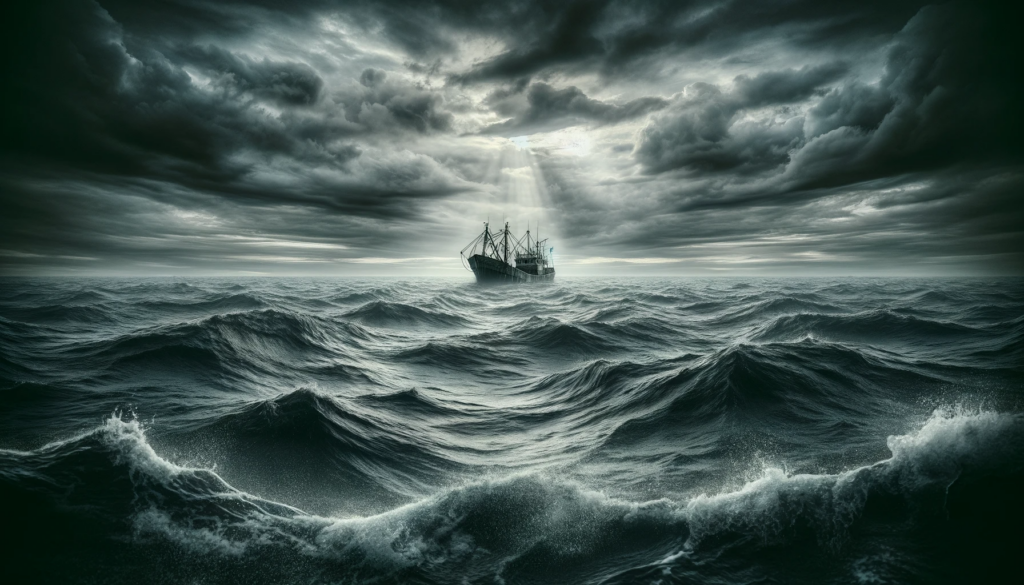Fishing for a Price: Human Trafficking in International Waters on Fishing Vessels
By Taylor Smith | Editor
December 8, 2023
—
Our failure to properly account for the use of our ocean and our ocean’s resources has increased the presence of illegal ocean activities. Overfishing, as a response to the overwhelming demand for inexpensive seafood, has forced fishers to travel far and wide to find viable fish stocks or board illegal fishing vessels for hardly any pay. Human trafficking on fishing vessels in international waters is a global tragedy that desperately needs attention. The lack of regulation and enforcement in international waters creates a culture and environment on large capture boats that can be hostile and life threatening. The Trafficking in Persons Report (TIP) is an annual report published by the United States Department of State that includes an analysis of human trafficking in every country, promising practices to combat trafficking, victim’s stories, and current trends.[1] The TIP identified Burma, Haiti, Thailand, Taiwan, Cambodia, Indonesia, South Korea, and China as countries dealing with trafficking and forced labor in the fisheries sector.[2] Forced labor on international fishing vessels occurs worldwide, affecting the lives of thousands of people.
Humans are exploited to work in severely unethical, dangerous, and uninhabitable conditions on fishing vessels. Forced labor encompasses many different activities including recruiting, harboring, obtaining, transporting, and providing when combined with the use of force or physical threats; psychological coercion; abuse of the legal process; a scheme, plan, or pattern intended to hold a person in fear of serious harm; or other coercive means to compel someone to work.[3] According to the United States Department of Health and Human Services, consequences of labor trafficking can include “helplessness, shame and humiliation, shock, denial and disbelief, disorientation and confusion, and anxiety disorders including posttraumatic stress disorder (PTSD), phobias, panic attacks, and depression.”[4] The victims are often “unfamiliar with the laws, cultures, and languages of the countries in which they have been trafficked because they are often subjected to coercion and intimidation including physical detention and debt bondage,” and they hesitate to report the crimes perpetrated against them because they “often fear retribution and forcible removal to countries in which they will face retribution or other hardship.”[5] To combat this issue, the congressionally enacted Forced Labor statute provides the best route for success.
The Trafficking Victims Protection Act (TVPA) of 2000 established human trafficking crimes, including forced labor and sex trafficking, in the United States.[6] Under the TVPA, the U.S. government has broad extraterritorial power to prosecute crimes including forced labor on any U.S. (or foreign) vessel operating in international waters.[7] However, a gap lies between the jurisdictional bounds of 18 U.S.C. § 1589, the Forced Labor statute, and Special Maritime Territorial Jurisdiction (SMTJ). Currently, 18 U.S.C. § 1589 does not fully extend to the SMTJ of the United States, whereas sex trafficking does under 18 U.S.C. § 1591.[8] Thus, if a person was suspected of human trafficking on a U.S. fishing vessel but is not a U.S. citizen and never enters U.S. territory but enters the SMTJ, that person would be subject to criminal liability for sex trafficking but not for forced labor committed in the SMTJ. The forced labor statute has the potential to create powerful change for human rights violations in international waters. The serious nature of forced labor crimes, as well as the likelihood that forced labor crimes occurring on fishing vessels will be committed in the SMTJ but outside current limits on U.S. jurisdiction over forced labor, warrant legislation that extends SMTJ to address this issue. Congress should extend SMTJ to the crime of forced labor by amending 18 U.S.C. § 1589.
[1] U.S. Dep’t of State of State, Trafficking in Persons Report (2020),
https://www.state.gov/reports/2020-trafficking-in-persons-report/.
[2] Id. at 55.
[3] 18 U.S.C. § 1589.
[4] U.S. Dep’t of Health & Hum. Servs., Labor Trafficking Fact Sheet (2012), https://www.acf.hhs.gov/archive/otip/fact-sheet/fact-sheet-labor-trafficking-english.
[5] United States v. Sabhnani, 599 F.3d 215, 253(2d Cir. 2010) (quoting TVPA, Pub. L. No. 106-386, § 102(b)(5), 114 Stat. 1464 (2000)).
[6] Victims of Trafficking and Violence Protection Act of 2000, Pub. L. No. 106–386, 114 Stat. 1464 (2000) (codified at 22 U.S.C. § 7101).
[7] Id.
[8] 18 U.S.C. § 1589.

